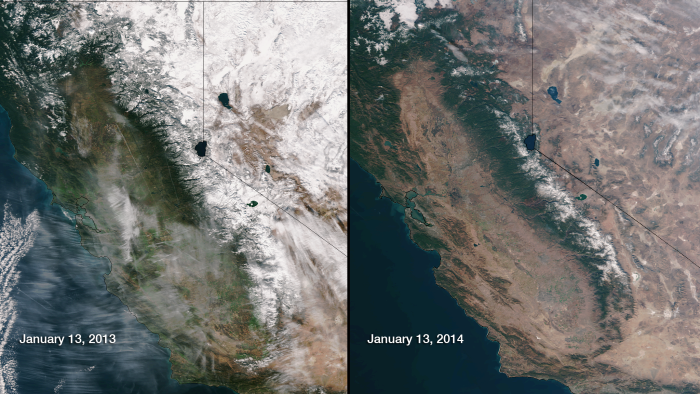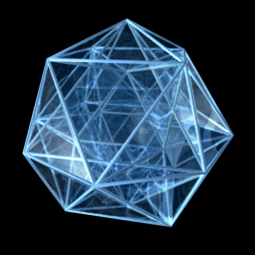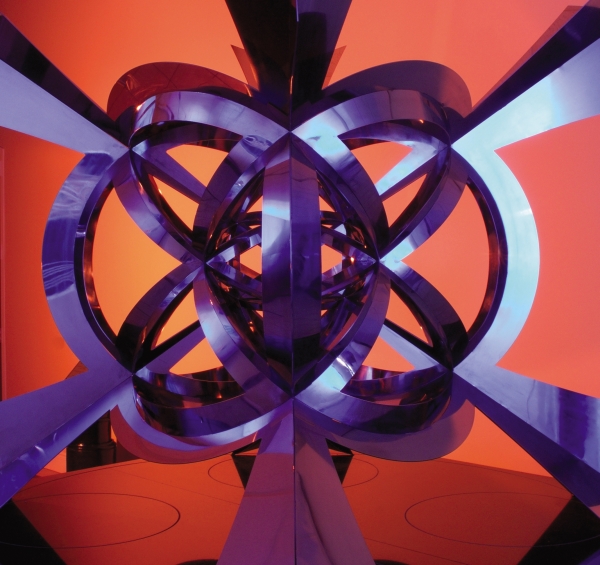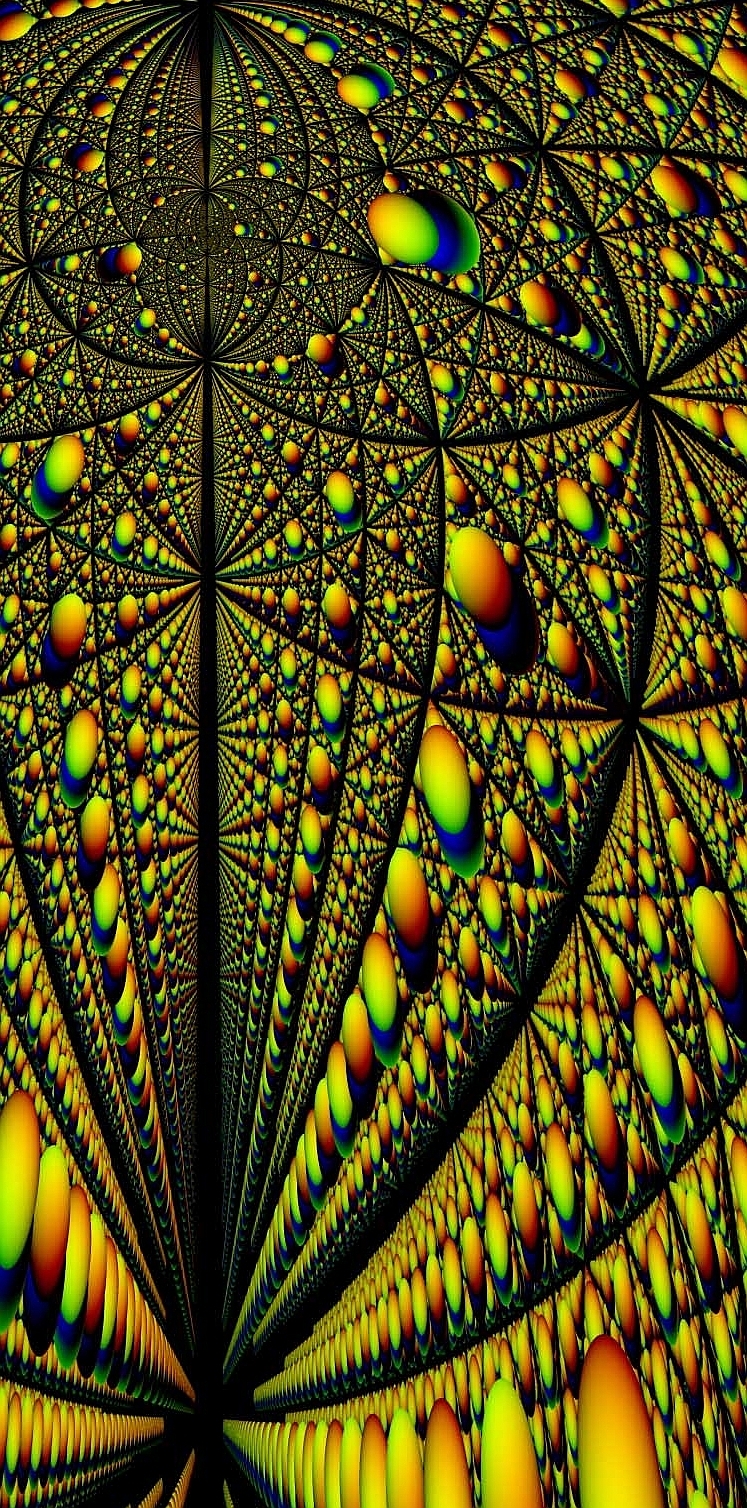
The picture shows snow in the mountains of California, 2013 and 2014. Snow usually provides 30% of California's water, so that was bad news. But 2015 was much worse.
"We're not only setting a new low; we're completely obliterating the previous record," said the chief of the California Department of Water Resources. There's now only 5% as much snow as the average over the last century!
California has been hit by new weather pattern: the Ridiculously Resilient Ridge. It's a patch of high atmospheric pressure that sits over the far northeastern Pacific Ocean and stops winter storms from reaching California. It's been sitting there most of the time for the last 3 winters.
We did get 2 big storms this winter. But the water fell mainly as rain rather than snow, because of record-breaking heat. It was enough to half fill Shasta Lake and Lake Oroville. But it didn't help the snow pack.
For the first time, the governor has imposed mandatory water restrictions: a 25% cut in water use in every city and town. This will save about 1.8 cubic kilometers of water over the next 9 months — nearly as much as Lake Oroville now holds.
He said:
People should realize we're in a new era. The idea of your nice little green grass getting lots of water every day — that's going to be a thing of the past.
But what about agriculture? In California, about 50% of water is used by 'the environment': rivers, wetlands, parks and the like. 40% is used by agriculture. 10% is left for businesses and residents.
Brown didn't impose any cuts on agriculture! That sounds unfair, and people are complaining. More water is used to grow walnuts than to keep Los Angeles going!
We definitely need to improve agriculture. But don't forget: for the second year in a row, farmers in California's big Central Valley are getting hit with big water cutbacks. The ones who get water from the State Water Project will receive only 20% of their usual amount.
Is all this due to climate change? I heard a wise answer to that question: instead of a definite yes or no, just: this is what climate change looks like. This is the kind of thing we can expect.
And on the Road to Paris, this week the US submitted a plan to cut carbon emissions by 25% by 2030... but that's another story. Or another part of the same big story.
What California is doing about the drought:
Water used by agriculture in California:
Make your own graphs of the California snowpack:
More on the Ridiculously Resilient Ridge or 'Triple R' by the guy who coined the term:
In February he wrote:
In this sense, the Triple R of 2014-2015 is notably different from 2013-2014. California has certainly received more precipitation this year on a liquid equivalent basis, though we're once again falling rapidly behind average as February turns out to be mostly dry. The extreme warmth and low snowpack, however, are very reminiscent of recent winters — as is the occurrence of infrequent but intense warm storms. It's interesting to note that nearly the entire western United States has been exceptionally warm in recent months, while the eastern part of the country remains locked in a recurring nightmare of extreme Arctic outbreaks and almost inconceivable snow accumulations in parts of New England. This overall setup—with a big Western ridge and a deep Eastern trough—has become known as the 'Warm West/Cool East' dipole pattern, and it has been a common feature of recent winters in North America. There are a number of hypotheses currently being investigated regarding the causes of an apparent recent increase in the occurrence of this pattern, though there's not yet compelling evidence pointing to a singular cause (that's a topic for a future blog post!).What is more certain, at least as far as California is concerned, is that our severe long-term drought is unlikely to improve substantially until this newly-invigorated pattern of persistent West Coast high pressure is no longer dominant.
I live on the edge of the desert in southern California. We tore up our lawn and planted beautiful plants that use less water. Drip irrigation instead of sprayers!
But we do indulge in some citrus trees. Here's the harvest!
Satsumas in front — they're like mandarins, but different. Meyer lemons at rear left — they're sweeter than ordinary lemons. Grapefruits at rear right — they're not very big, perhaps because our tree is still young and struggling.
What's a 'mandarin'? It's the mandarin orange, Citrus reticulata, often marketed as a 'tangerine'. According to DNA studies, the mandarin is one of the 4 ancestors of all other citrus species, which arose through hybridization and breeding. The other 3 are the the citron, the pomelo, and something called a papeda.
Among these 4 citrus ancestors, mandarins are the only really sweet ones, so they were used to create many of the fruits people like now.
For example, a Meyer lemon is probably a cross between a true lemon and a mandarin or an orange. A grapefruit is a cross between an orange and a pomelo — a huge fruit that looks like a grapefruit on steroids. And an orange is itself probably a cross between a pomelo and a mandarin!
It's all very complicated:
Luckily you don't need to know this stuff to enjoy growing and eating citrus!
Time to harvest the kumquats! Our tree is packed with them. It's great to eat the whole fruit, since the peel is sweet yet packed with flavorful oil, mostly limonene.
Limonene is also what gives orange and lemon peels their special smell. It's one of a group of hydrocarbon molecules called terpenes, which are found in pine needles, cinnamon, cloves, ginger, camphor, mints, and the sap of many trees. Plants produce terpenes to repel insects! Trees also release more terpenes in warmer weather, creating a haze that acts as a natural form of cloud seeding. The clouds reflect sunlight, letting the forest regulate its temperature.
Limonene is one of the simplest terpenes. It's a hexagonal ring of carbons with a single extra carbon attached to one corner and a Y-shaped group of three carbons attached to the opposite corner... all decorated by hydrogens.
The hexagon of carbons is not a benzene ring: it's a cyclohexene, meaning that each carbon is connected to the next with a single bond, except for one double bond.
Puzzle: so, how many hydrogen atoms are there in cyclohexene? Looking up the answer is cheating... you can figure it out from first principles using what I said.
Time to eat some more kumquats! For various replies to the puzzle,
check out my G+ post. And for more of the wonderful chemicals that make
citrus fruits so great, read my July
2nd, 2006 diary entry!
April 8, 2015

When my uncle first tried to teach me calculus I thought it was confusing. I already wanted to be a mathematician. So I decided to be a mathematician who wouldn't use calculus.
A few weeks later I wasn't scared of calculus anymore, thanks to the wonderful book Calculus Made Easy by Silvanus Thompson, which he gave me.
Later, when I took calculus in high school, it became fun to tackle tough integrals. The reason it's fun is that a limited set of rules lets you do a lot of integrals, yet there's still some art involved in doing them well. It's like a game.
(This was before computers were programmed to do integrals much better than people can.)
Later, I learned that only a small fraction of the integrals you can write down can be done using the rules you learn in school. For most, the answer is some function you can't even write down using the usual kit of high-school functions: addition, subtraction, multiplication, division, exponentials, logarithms, trig and inverse trig functions.
I also learned that most professional mathematicians consider it uncool to get really good at doing integrals: it's just one step up from memorizing digits of pi. Professional mathematicians want to learn about stuff like Shimura varieties, or motivic cohomology — stuff you can't even begin to explain to ordinary folks. This is what it takes to impress other mathematicians.
Still, integrals can be fun. Sometimes I teach calculus at U.C. Riverside - though now it's mainly poorly-paid "lecturers" who have to do this job. When I teach calculus, I usually focus on the students who are having trouble. I want everyone to learn the stuff! Unfortunately this means I never spend time showing the good students fun tricks.
I realize now that I should spend a little time doing "integrals from hell" like this one here. First of all, it would be fun for the better students. It shows there's a kind of athletic element to math, where you don't just learn to walk: you learn to run insanely fast! Second of all, it makes the easy integrals seem easier.
This particular integral is fun because at first glance it looks horrible, yet it falls quickly to high-school tricks. It's fun to see how these tricks make it simpler! Then you get something that's a bit grungy and boring. It's just the first steps that are fun.
Puzzle: What's a nice way to start doing this integral?
I got this integral from here:
They post lots of fun integrals—good puzzles if you still remember your high school calculus and you're not too much of a professional mathematician to enjoy this sort of thing. You can see solutions here:

On Monday night, artists built this monument to Edward Snowden in Brooklyn. The next day, it was taken down. Will there be a permanent one someday?
Martin Luther King was put in jail 29 times, and now there's a monument to him in Washington DC. But it was built only in 2011, forty-three years after he was killed.
If Snowden ever gets a monument, here are some quotes of his they could carve on it:
There can be no faith in government if our highest offices are excused from scrutiny—they should be setting the example of transparency.I would rather be without a state than without a voice.
I don't see myself as a hero because what I'm doing is self-interested: I don't want to live in a world where there's no privacy and therefore no room for intellectual exploration and creativity.
After the statue was removed by park officers, a group of artists who call themselves "The Illuminator"—not related to those who built the original sculpture—used laptops and projection equipment to cast an image of Snowden in a haze of smoke at the spot where the sculpture had been.

This week I'm visiting Penn State University. I'm giving two talks about geometry:
Something amazing happens when you roll a ball on another ball whose radius is exactly 3 times as big! The geometry of objects rolling without slipping or twisting is always fun — but in this particular case the problem gets extra symmetries, which are best understood using an 8-dimensional number system called the 'split octonions'.
There's a specially beautiful way to pack balls in 24 dimensions, called the Leech lattice. When physicists classified the algebras that could describe observables in quantum mechanics, they found a weird possibility: a 27-dimensional one called the exceptional Jordan algebra. It turns out that the Leech lattice fits into the exceptional Jordan algebra in a nice way... which comes from the octonions. So all this stuff fits together! This talk is part of the "Geometry Luncheon Seminar", where mathematicians eat lunch and talk about geometry. You can see my notes here:
The first talk is about work I did with John Huerta and James Dolan, and it will feature some fun animations made by Geoffrey Dixon. The second is about work with Greg Egan.
The actual reason I'm at Penn State is to give a guest lecture at John Roe's undergrad course on Mathematics for Sustainability. I want to teach a course on math and environmental issues. It'll be good to hear how he's been doing this. But I thought it would be fun to talk about some other things too.
I'll also visit one of my old haunts, the Institute for Gravitation and the Cosmos, where Abhay Ashtekar, Eugenio Bianchi and others are working on loop quantum gravity. And I'll talk to Jason Morton about network theory. It should be a busy, fun week.
But first I have to work on my talks...
This image above, made by Jason Hise, shows a '24-cell', a regular polytope in 4 dimensions. There's a sculpture of this shape in the math department at Penn State! It was designed by the mathematician Adrian Ocneanu. I haven't been here since it was built so it will be fun to see:

Are you a teacher or parent that wants to teach a student about advanced neurotechnologies? You are in luck! After 3 long years of R&D, the RoboRoach is now ready for its grand release! We are excited to announce the world's first commercially available cyborg! With our RoboRoach you can briefly wirelessly control the left/right movement of a cockroach by microstimulation of the antenna nerves. The RoboRoach is a great way to learn about neural microstimulation, learning, and electronics!We are recently ran a successfully-funded kickstarter campaign to fund the release of our new RoboRoach! The hardware and firmware development are complete and we are now shipping!
Product Details
The RoboRoach "backpack" weighs 4.4 grams with the battery, and each battery will last over a month! Following a brief surgery you perform on the cockroach to attach the silver electrodes to the antenna, you can attach the backpack to the roach and control its movement for a few minutes before the cockroach adapts. When you return the cockroach to its cage for ~20 minutes, he "forgets" and the stimulation works again. Once you receive your RoboRoach in the mail, follow our online surgery instructions and videos and you will soon be on your way to becoming an expert in neural interfaces. After about 2-7 days, the stimulation stops working altogether, so you can clip the wires and retire the cockroach to your breeder colony to spend the rest of its days making more cockroaches for you and eating your lettuce.Technical Specs
1x Free iOS or Android 4.3+ application for remote control
1x Bluetooth Roboroach backpack control unit
1x 1632 RoboRoach Battery
3x Electrode Sets (to implant 3 Roaches)
View our RoboRoach Ethics Statement
Backyard Brains has developed ethical guidelines for all our products. You can read more in our statement regarding our use of insect for experiments at: http://ethics.backyardbrains.com
I feel ethical qualms about taking away the autonomy of an animal this way, and their ethics statement doesn't really address that. This is the closest they come:
Criticism: Modifying a living creature to make a toy is wrong.The RoboRoach circuit is not a toy. This new bluetooth version is a powerful low-cost tool for studying neural circuits, allowing for students to make discoveries. High school students in New York, for example, have discovered random stimulation causes much slower adaptation times. We have scientist and high school educator colleagues who are mentoring students in novel behavioral experiments using the RoboRoach circuit. Some highlights will be posted on our website soon. By focusing on the question of whether the RoboRoach is a "toy", they dodge the harder question of when it's okay to override the nervous system of an animal and make it do what you want. Perhaps feeling a bit nervous about this, some of the cyborg roach developers say they want to use it as a "rescue robot" that can crawl around and hear people trapped under collapsed buildings. I think most people would say this is okay, at least if it actually works.
For a critical view on the ethics, see:

This picture by John Valentine shows a ball inside a mirrored spheroid... together with all its reflections! The real ball is at lower right. The rest are reflections. They form crazy patterns — the kind of thing mathematicians think about when they can't sleep at night.
The ball is lit from three directions with soft red, green, and blue lights, so we can see things more clearly. The view simulates an ultra-wide-angle camera. For more details and other views, go here:
You can get John Valentine's really big version here. This is 16384 × 16384 pixels and about 16 megabytes. If you know a nice way to display such a big image online, which makes it easy to zoom in on pieces, please try it and let me know!
Puzzle 1: What creates the black 'zone of invisibility', and the fractal hexagonal patterns near the zone of invisibility?
I don't really know the answer in detail — this could be a great math project. But I should say that the black regions arise from the fact that the ray-tracing program only allows for 256 reflections; they would get smaller if this number were increased.
I've watched a number of movies where the climactic final scene involves people fighting inside a hall of mirrors, where it's hard to tell who is real and who is a reflection. Orson Welles' 1947 classic Lady from Shanghai may be the first - if you haven't seen that, you should definitely watch it. Another that stands out is Bruce Lee's Enter the Dragon.
Puzzle 2: What other movies or stories do you know involving this theme?
April 24, 2015
A rotifer is an animal that lives in water and sweeps food into its mouth with tiny hairs. There are many kinds, most less than a millimeter in length. They can eat anything smaller than their head.
The toughest are the bdelloid rotifers. These can survive being completely dried out for up to 9 years! When they dry out, they sometimes crack. Even their DNA can crack... but when they get wet, they come back to life!
Thanks to this strange lifestyle, their DNA gets mixed with other DNA. Up to 10% of their active genes come from bacteria, fungi and algae!
Scientists have found DNA from 500 different species in the genes of a rotifer from Australia. "It's a genetic mosaic. It takes pieces of DNA from all over the place," said one of the study's authors. "Its biochemistry is a mosaic in the same way. It's a real mishmash of activities."
Perhaps because of this, bdelloid rotifers don't bother to have sex.
Their ability to survive dry conditions makes them great at living in desert lakes and mud puddles that dry up. But they also use this ability to beat some parasites. When they dry out, the parasites die... but the rotifers survive!
On top of all this, bdelloid rotifers can survive high doses of radiation. I think this is just a side-effect of having really good genetic repair mechanisms. In fact, it turns out that many organisms able to endure lots of radiation are able to endure dehydration.
Puzzle 1: What does 'bdelloid' mean?
Puzzle 2: What other words begin with 'bd'... and why?
For some answers to the puzzles, read the comments to my G+ post. Here's the paper that discovered that 10% of active genes and 40% of all enzyme activity in some bdelloid rotifers involve foreign DNA:
For my May 2015 diary, go here.